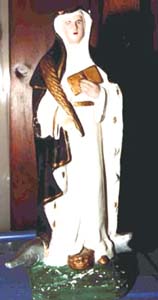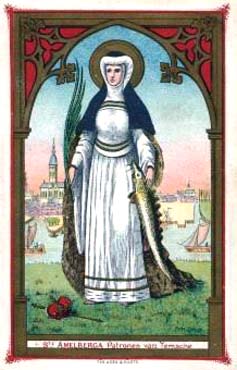인창동성당 게시판
|
7월10일 성녀 아멜리아(아말부르가)♬Occuli Omnium |
|---|
|
축일:7월10일 성녀 아멜리아(아말부르가) St. Amelia(Amalburga) Sant’ Amalberga di Maubeuge Vedova e monaca Born :at Brabant Died :690; buried beside her husband at the Lobbes monastery, her relics have been in Saint Peter’s abbey church in Ghent, Belgium since 1073
브라반트 태생인 아멜리아는 그의 나이 불과 13세 때, 비트겔 백작에게 시집을 가서 세 자녀를 낳았는데, 이들이 곧 성녀 구둘라, 성녀 라이넬다 그리고 캄브라이의 성 에메베르토이다.(Saint Gudula, Saint Reineldis, and Saint Emebert)
남편 비트겔이 롭브스에서 베네딕또회 수도자가 되자, 그녀 역시 모베쥬의 수도원에서 같은 규율을 지키는 수녀가 되어, 성 오베르트에게 서약을 하였다. 그녀는 여생을 매우 엄격하게 지내다가, 남쳔이 운명한 후 그녀 역시 사망하여 남편 옆에 묻혔다. (성바오로수도회홈에서)
*성베네딕토 아빠스 축일:7월11일.게시판1267번
베네딕도 성인의 십자가
성 베네딕도회 성 베네딕도(480-560년경)는 이탈리아의 누르시아에서 탄생하였다. 그는 진실로 하느님을 찾고자 세상의 모든 것을 포기하고 수비아꼬 동굴에서 3년 동안 은수생활을 한 후, 몬떼까시노에 수도원을 세우고, 거기서 수도규칙서(Regula Benedicti : RB)를 저술하였다. 이 규칙서는 이후 서방 수도승생활의 초석이 되었다.
수도생활(修道生活, 라:vita religiosus,영:religious life) 세례를 통해 하느님의 자녀가 된 그리스도교인들은 모두 그리스도를 따르라는 하느님의 부르심을 받는다. 수도생활은 바로 이 부르심에 응답하는 여러 방법들 중 하나이다. 수도생활이란 그리스도를 보다 철저하게 따르기 위하여 자기를 포기하는 삶이다. 이 자기포기는 보통 가난, 정결, 순명의 세가지 서원으로 구체적으로 표현된다. 이러한 생활을 하는 사람을 일컬어 수도자(religiosus)라 하며, 남자는 수사(修士), 여자는 수녀(修女)라고 한다.
다양한 수도회들 역사 : 교회 초창기부터 재산을 포기하고 독신을 지키며 교회에 봉사하기 위해 개인의 욕망을 포기한 동정녀들과 금욕자들이 있었지만, 엄밀한 의미에서의 수도 생활이 시작된 것은 4세기 이후부터이다. 수도생활 운동은 교회의 세속화에 대한 하나의 반동으로 일어났는데 당시 열심한 신자들은 도시를 떠나 사막과 광야로 들어가 특수한 삶의 양식을 형성하게 되었다.
이들 중 에집트의 성 안또니오(Antonius)가 대표적 인물로서 그는 은수생활의 창시자이자 모든 수도자들의 아버지라 불리운다. 초기 동방 수도생활은 외딴 곳에 홀로 사는 은수생활과 함께 모여 사는 공생수도생활, 그리고 서로 가까이 모여 사는 반은수생활 등 세가지 형 태가 공존하였다. 이 동방 수도생활은 서방에 영향을 미쳐 성 베네딕도의 수도규칙이 생겨났고, 이 규칙서는 이후 서방 수도생활을 지배하게 되었다.
*에집트의 성 안토니오 아빠스 축일:1월17일.게시판1572번
수도승생활(修道僧生活, 영: Monastic life , Monasticism) 수도생활 초기부터 이어져 내려오는 전통적인 수도생활을 의미한다. 즉 그리스도를 더욱 철저히 추종하고 오로지 하느님을 찾기 위하여 세상으로부터 물러나 사막이나 광야로 들어간 은수자들이나 독수자들의 삶의 전통을 잇는 수도생활을 말한다.
수도승생활을 하는 수도자를 우리말로 수도승(修道僧)이라 하는데 수도승(Monachus, Monk)이란 말은 원래 불교 용어이지만 일반적으로 쓰이는 수도자(Religious)라는 개념에 포함되면서도 승려적 생활전통을 따르는 수도회들에 속한 수도자를 따로 지칭할 때 그리스도교에서도 사용하고 있다.
이 말은 그리스어 ’monos’(홀로)에서 유래했는데 원래 ’결혼하지 않은 자’ 또는 ’독신자’란 의미에서 ’홀로 사는 사람을’나타내었다. 따라서 처음에는 광야에서 살던 ’은수자’(Hermit, Eremita)나 ’독수자’(Anchorite, Anachorita)를 가리켰는데 점차 그 의미와 내용이 발전하면서 후에는 ’회수도승’(會修道僧. Cenobite, Cenobita)까지 포괄하는 단어가 되었다.
따라서 오늘날 ’수도승’이라 할 때 일반적으로 까말돌리회, 실베스트로회, 발롬브로사회, 올리베따노회 등 베네딕도회 연합에 속한 수도회들, 시토회, 트라피스트회, 카르투시오회에 속한 수도자들을 일컫는다. (성 베네딕도회 왜관 수도원홈에서)
♬Occuli Omnium-베네딕도수도원
AMALBURGA
Also known as Amalberga; Amalia; Amelia Memorial 10 July Profile Seventh century relative of Blessed Pepin of Landin. Married early to Count Witger. Mother of Saint Gudula, Saint Emebert, and Saint Reineldis, all of whom she taught herself, including religion. When the youngest was grown, both Amalburga and her husband retired to Benedictine monasteries, the Count to Lobbes, Amalburga to Maubeuge where she embraced a life of asceticism and prayer. Received the veil from Saint Willibrord. She once crossed a lake on a giant sturgeon, which led to her representation on or with a fish. Born at Brabant Died 690; buried beside her husband at the Lobbes monastery, her relics have been in Saint Peter’s abbey church in Ghent, Belgium since 1073 Patronage against arm pain, against bruises, against fever, arm pain, bruises, fever, Ghent, pain in the arm Representation holding a palm and open book; with a crown at her feet; standing on a giant sturgeon or other fish
St. Amalberga St. Amalberga, otherwise Amelia, was related in some way to Pepin of Landen. Whether she was sister or niece, the Bollandists are not sure. She was married to Witger and became the mother of three saints, Gudila, Reinelda, and Emembertus. The Norman chroniclers speak of her as twice married, which seems to be erroneous. Nor are Pharailda and Ermelende admitted by the Bollandists to have been her children. She and her husband ultimately withdrew from the world, he becoming a monk, and she a nun. There is very great confusion in the records of this saint, and of a virgin who came a century after. To add to the difficulty a third St. Amalberga, also a virgin, appears in the twelfth century. The first two are celebrated simultaneously on 10 July.
Acta SS., III, July. T.J. CAMPBELL Transcribed by Vivek Gilbert John Fernandez Dedicated to The Holy Catholic Church in her defense of life.
Sant’ Amalberga di Maubeuge Vedova e monaca
10 luglio secolo Saintes nel Brabante - † Maubeuge (Belgio) VII sec.
Antichissima era la tradizione di questo nome tra gli Ostrogoti, tanto che la loro dinastia era appunto quella degli ‘Amali’. Il nome e attualmente scomparso, mentre si e molto diffusa la forma abbreviata di ‘Amalia’. Di s. Amalberga ve ne sono tre, di cui due contemporanee fra loro, e si festeggiano lo stesso giorno il 10 luglio, a volte anche sotto il nome di ‘Amalia’. S. Amalberga vergine, secondo una ‘Vita’ scritta da un monaco dell’abbazia di S. Pietro di Gand, era nata nelle Ardenne, nella ‘villa Rodingi’ (Belgio), allevata a Bilsen da santa Landrada e avrebbe ricevuto il velo monacale da s. Willibrordo. Visse tra il VII e l’VIII secolo; trascorse i suoi ultimi anni nella cittadina di Tamise, dove mori nella seconda meta del secolo VIII ed a Tamise fu sepolta. Un secolo dopo le sue reliquie furono traslate nel monastero di S. Pietro di Gand (Belgio), dove furono solennemente esposte nel 1073. Di lei parla anche un diploma di Carlo il Calvo imperatore (823-877), che in data 1° aprile 870, attesta che le reliquie di s. Amalberga vergine, erano conservate in quel tempo, dai monaci di S. Pietro di Monte Blandino a Gand. La festa si celebra il 10 luglio.
Dell’altra s. Amalberga detta di Maubeuge, le notizie pervenutaci e redatte da un monaco di Lobbes, sono ritenute in gran parte leggendarie e non affidabili. Nacque a Saintes (Brabante) nei Paesi Bassi, fu sposa di Witger e madre di Emeberto (che diverra poi vescovo di Cambrai) e delle sante Reinalda e Godula. Amalberga, dopo la nascita di Godula e dopo che suo marito era morto, lascio il mondo per abbracciare la vita religiosa a Maubeuge; ella avrebbe ricevuto il velo monastico dalle mani di s. Oberto e sarebbe morta alla fine del secolo VII. Da Maubeuge il suo corpo fu trasportato all’abbazia di Lobbes (Hainaut) attuale Belgio. La sua festa si celebra il 10 luglio. Autore: Antonio Borrelli
|






